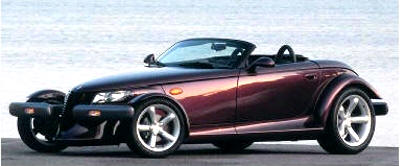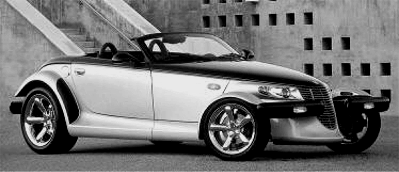1997 Plymouth Prowler Development
For
sheer impact, though, nothing could match the 1997
Prowler, the most-exciting Plymouth in a generation. It
was unlike anything ever offered by a mainstream
automaker, being a modern reincarnation of the iconic
American hot rod.
Like the Dodge Viper before it, Prowler began as a
concept, premiering at the 1993 Detroit Auto Show amid
rabid pleas to "Build it!" Once more, Chrysler president
Bob Lutz gave his full endorsement to a fairly
outrageous automobile aimed squarely at car buffs like
himself.
Again sharing his enthusiasm were design chief Tom Gale,
long an active hot rod hobbyist, and Advanced Design
director Neil Walling, who oversaw the concept's
development from an idea suggested by a staffer at the
company's California design outpost, Chrysler Pacifica.
Though hardly the sort of car expected of a "value
brand," Prowler promised to do for Plymouth what Viper
had for Dodge -- namely, get people talking and change
their minds. Indeed, Chrysler viewed its two-seat retro
roadster has having just the right "shock value" for
resuscitating Plymouth's moribund image and low "brand
awareness" among consumers.
 The 1997 Plymouth Prowler was a crowd-pleasing hot-rod. |
There was high-tech seriousness beneath the hot-rod fun,
as Prowler became Chrysler's low-volume laboratory for
nontraditional construction and materials. For example,
aluminum was used not only for an all-independent
suspension but the entire chassis and much of the body.
In fact, Prowler packed more aluminum than any car in
Chrysler history -- some 900 pounds of it --
construction rivaled only by the exotic Honda-built
Acura NSX sports car. The result was a lean machine with
about the same length as a Porsche 911 but weighing well
under 2900 pounds.
Other weight-watching measures included a lateral
dashboard brace made of costly magnesium, the industry's
first cast aluminum brake rotors (rear only; front discs
were iron Voyager parts), and plastic-like sheet molding
to shape the quarter panels, vintage cycle-type front
fenders, and a pointy nose skimming just 4.5 inches
above the pavement.
Helped by a raked-forward profile and broad 76.5-inch beam, the Prowler turned heads like nothing else on the street. The only changes from the stunning concept were more prominent front "bumperettes" and headlights, both to satisfy the feds. Wheels were handsome five-spoke alloys measuring 1737.5 inches fore and a massive 20310 aft, and you could have any color at first so long as it was vivid Prowler Purple. The manual top, a black fabric affair, stowed easily beneath a rear-hinged trunklid -- and most always was. Prowler, after all, was about lookin' good. There was no room for introverts.
Or
much of anything else. The front-tapering '30s-style
body left footwells uncomfortably narrow (though wider
than on the concept). Standard run-flat tires eliminated
the need for a spare, but the trunk was nearly useless,
squeezed from below by the fuel tank (itself laughably
small at 12 gallons) and a rear transaxle, also new for
Chrysler. The latter contributed to front/rear weight
distribution of 45/55 percent, making Prowler quite
nimble on dry roads despite a long 113-inch wheelbase.
And for times when you had to carry more than a couple
of pizzas, Chrysler offered a small accessory trailer,
shaped like the tail, for about five-grand.
But the fat tires with their ultra stiff sidewalls "find
every bump," as Car and Driver noted, and could
be way too slippery in the rain. And like Viper,
antilock brakes and traction control weren't available,
yet a number of luxuries were standard: air
conditioning, power windows and mirrors, leather
upholstery, high-power sound system, even a gee-whiz
tire-pressure monitor.
Hot-rod purists also shook their heads at Prowler's powertrain: a 3.5-liter V-6 sending a modest 214 bhp through a four-speed automatic transmission. Like much of the interior, these were off-the- shelf components used to keep price reasonable, which it was at an initial $38,300. Yet despite that, the low weight and standard AutoStick manual-shift feature, Prowler was nowhere near as fast as it looked. Car and Driver's results were typical: 0-60 in 7 seconds flat, a standing quarter-mile of 15.6 at 87 mph -- pretty tame.
Overall, C/D viewed Prowler as "awash in
contradictions. Hot rods have V-8s and manual gearboxes.
The Prowler offers neither. Hot rods are supposed to
ride badly and handle badly, then set fire to the
dragstrip. Instead, the Prowler handles almost like a
sports car but is a relative flatliner on the dragstrip.
Hot rods are supposed to have individualized exteriors
…[not] one level of trim. Hot rods customarily sport
spartan, handmade interiors. The Prowler's is more plush
and option laden than a BMW Z3's."
On the other hand, "It's a convertible, the drivetrain
is dead reliable, it can be driven [every day] as long
as there's no snow, there's a three-year/36,000-mile
warranty, and the vehicle regularly twists the needle
right off … the gawk meter."
As it happened, though, Prowlers didn't begin reaching dealers until August 1997, delayed by last-minute production glitches. As a result, model-year output was only 312 units instead of the 2000-3000 planned, and a bidding war broke out among would-be owners.

